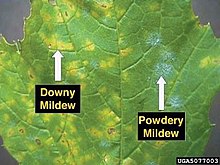Downy (mildew)
| Downy mildew | |
|---|---|

Example of Downy mildew (left) along with powdery mildew on a grape leaf
|
|
| Causal agents | oomycetes |
| Hosts | plants |
Downy mildew refers to any of several types of oomycete microbes that are obligate parasites of plants. Downy mildews exclusively belong to Peronosporaceae. In commercial agriculture, they are a particular problem for growers of crucifers, grapes and vegetables that grow on vines. The prime example is Peronospora farinosa featured in NCBI-Taxonomy and HYP3. This pathogen does not produce survival structures in the northern states of the United States, and overwinters as live mildew colonies in Gulf Coast states. It progresses northward with cucurbit production each spring. Yield loss associated with downy mildew is most likely related to soft rots that occur after plant canopies collapse and sunburn occurs on fruit. Cucurbit downy mildew only affects leaves of cucurbit plants.
Initial symptoms include large, angular or blocky, yellow areas visible on the upper surface. As lesions mature, they expand rapidly and turn brown. The under surface of infected leaves appears watersoaked. Upon closer inspection, a purple-brown mold (see arrow) becomes apparent. Small spores shaped like footballs can be observed among the mold with a 10x hand lens. In disease-favorable conditions (cool nights with long dew periods), downy mildew will spread rapidly, destroying leaf tissue without affecting stems or petioles.
Because the downy mildew pathogen does not overwinter in midwestern fields, crop rotations and tillage practices do not affect disease development. The pathogen tends to become established in late summer. Therefore, planting early season varieties may further reduce the already minor threat posed by downy mildew.
Fungicides applied specifically for downy mildew control may be unnecessary. Broad spectrum protectant fungicides such as chlorothalonil, mancozeb, and fixed copper are at least somewhat effective in protecting against downy mildew infection. Systemic fungicides are labeled for use against cucurbit downy mildew, but are recommended only after diagnosis of this disease has been confirmed. In the United States, the Environmental Protection Agency has approved oxathiapiprolin for use against downy mildew.
...
Wikipedia
